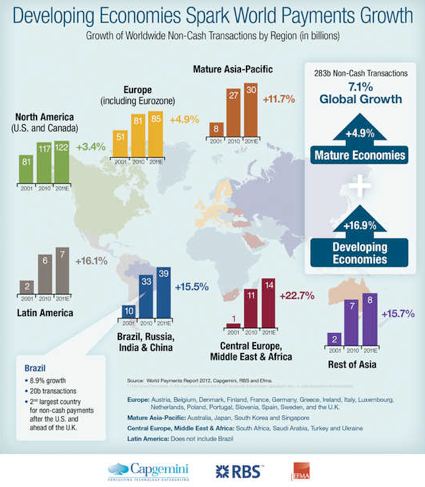Debit Cards Continue to Win Market Share from Credit Cards
World Payments Report reveals customer-centric innovation must be priority for banks.
PARIS — Debit cards continue to gain market share from credit cards, and the use of electronic and mobile payments continues to show exponential growth concludes the World Payments Report (WPR1) 2012 released today by Capgemini, RBS, and Efma.
Two other major themes highlighted by the report are: the relationship between regulation and innovation, with some regulation challenging innovation; and the fact that the BRIC (Brazil, Russia, India, China) concept is no longer valid in payments, with Brazil now the second-highest ranking country by payment volumes after the US. There were 20 billion non-cash transactions in Brazil in 2010, compared with 13.1 billion in Russia, India and China combined. The report confirms the resilience of payment volumes, as global non-cash payments volumes grew by 7.1 percent in 2010, reaching 283 billion, although early 2011 indications show an additional 8.2 percent growth. In 2010, payment volumes in developing markets grew at a much faster rate (16.9 percent), boosted by a more than 30 percent increase in both Russia and China.
Rise of the debit card and m-payments
As more consumers embrace electronic, mobile and debit card payments, industry innovation will continue to focus heavily on these payment methods. According to industry analysts, there were an estimated 28.3 billion electronic and mobile payment transactions globally2 in 2011, and in 2010 more than one in three non-cash payments globally was made using a debit card, up 15.2 percent, according to the report. But with only 2.1 percent of all mobile users making m-payments, the potential for additional growth is still huge, with mobile payments set to reach 17 billion by 2013 and e-payments 31.4 billion by 2013. “Debit card transactions continue to take market share from other types of payment methods because they easily allow people to bypass the use of cash,” said Kevin Brown, Global Head, Transaction Services Product, International Banking, RBS. “As more and more consumers move to mobile and other electronic payments, we’ll continue to see the exponential growth of innovative payment solutions.”
Regulation can be both an obstacle and a driver to innovation
The WPR also reveals how the relationship between regulation and innovation can challenge banks’ capacity to undertake customer centric innovation. Partly as a result of the Eurozone debt crisis, European banks are complying faster than originally expected with the Basel III objectives, but as a result they have less capacity to focus on innovation. The report concludes that regulation can have direct – or indirect – beneficial consequences for payments innovation but not for all cases. “Regulation must not be created in regional isolation. Its central goal needs to drive innovation forward, and deliver customer benefits that push industry boundaries,” said Jean Lassignardie, Chief Sales and Marketing Officer, Capgemini Global Financial Services.
Asked what is driving innovation, more than two-thirds of respondents cited customer retention and acquisition as the two most critical areas for innovation. But in customer service, banks face tougher challenges than their non-bank counterparts, which in some cases have been able to focus on being customer-centric, without the same regulatory pressures.
The report also shows that the real payment innovators are organizations with a granular understanding of the needs of their target customer segments, as well as their own capability to innovate. The WPR cites Japanese telecommunications organization NTT DOCOMO, which has succeeded in quickly growing to create a critical mass of 35 million registered users (or half the market) with its “Mobile Wallet”. Mobile Wallet, or Osaifu-Keitai in Japanese (as known locally), is a proximity payments instrument enabled through compliant mobile phones, with services going beyond just NFC payments and including: electronic money, identity card, loyalty card, public transport ticketing (includes railways, buses, and airplanes), and credit card. By using open standards, building on existing payment instruments (such as credit cards) and considering loyalty programs and CRM services for merchants, the program as proven successful over the past eight years.

